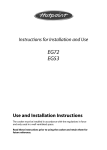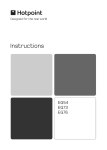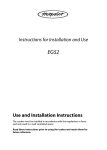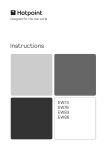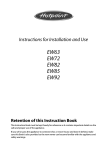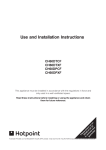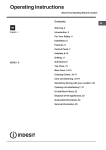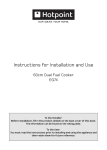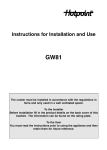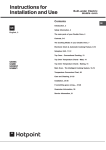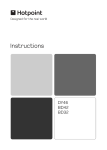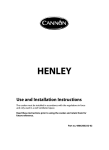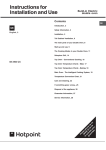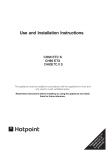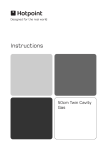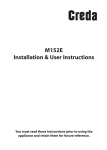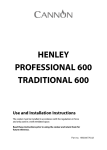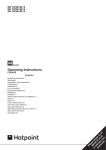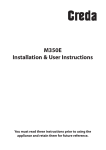Download Hotpoint EG71 User's Manual
Transcript
Instructions for Installation and Use EG71 This appliance shall be installed in accordance with the regulations in force and only used in a well ventilated space. Read the instructions before installing or using the appliance and retain them for future use. The rating label is located below the oven door on the plinth panel. CONTENTS PAGE Introduction 3 For Your Safety 4-5 Oven Timer Operation 6-11 Control Panel Hotplate Grilling 12 13-14 15 - 16 Top Oven 17 Main Oven 18 Eco Setting 18 - 19 Oven Temperature Charts 20 - 21 Care & Cleaning 22 - 24 If Something Goes Wrong Installation Service Key Contacts This appliance conforms to the following EEC Directives: Gas Appliances 90/396/EEC 93/68/EEC Low Voltage Equipment 73/23/EEC 93/68/EEC Electromagnetic Compatibility 89/336/EEC 92/31/EEC 93/68/EEC 2 25 26 - 30 31 Back Cover INTRODUCTION To help you make the best use of your cooker, PLEASE READ THIS BOOKLET CAREFULLY. Your new cooker is guaranteed and will give lasting service. The guarantee is only applicable if the cooker has been installed in accordance with the Installation Instructions. The cooker is designed specifically for domestic use and responsibility will not be accepted for use in any other installation. When the cooker is first used, a slight odour may be noticed – this should cease after a short period of use. Ensure that the room is well ventilated (e.g. open a window or use an extractor fan) and that any pets are removed from the room until the smell has ceased. FEATURES OF THE EG71 Hinged Glass Lid High Speed Burners Simmering Burners Removable Roof Control Panel Top Oven / Grill Shelf Grill Pan with removable Handle and Wire Food Support Top Oven / Grill Stayclean Oven Liners Stayclean oven liners Oven Shelves Meat Pan Plinth Ventilation Slots Rating Label Cooling fan: A gentle flow of air will be blown below the control panel when the oven or grill controls are turned on. 3 FOR YOUR SAFETY Please read the precautions below before using your cooker. ALWAYS . . . ALWAYS make sure you understand the controls before using the cooker. ALWAYS check that all controls on the cooker are turned off after use. ALWAYS stand back when opening the oven door to allow heat to disperse. ALWAYS use dry, good quality oven gloves when removing items from the ovens. ALWAYS take care when removing items from the grill when the oven is on, as the contents may be hot. ALWAYS keep the oven and grill doors closed when the cooker is not in use. ALWAYS place pans centrally over the hotplate burners and position them so that the handles cannot accidentally be caught or knocked or become heated by other burners. ALWAYS keep the cooker clean, as a build up of grease or fat from cooking can cause a fire. ALWAYS allow the cooker to cool before cleaning. ALWAYS follow the basic principles of food handling and hygiene to prevent the possibility of bacterial growth. ALWAYS keep ventilation slots clear of obstructions. ALWAYS turn off the electricity supply before cleaning or replacing the oven lamp. ALWAYS refer servicing to CORGI registered appliance service engineers. ALWAYS remove any spillage from the hob lid before opening. 4 FOR YOUR SAFETY NEVER . . . NEVER leave children unsupervised where the cooker is installed as all surfaces will get hot during and after use. NEVER allow anyone to sit or stand on any part of the cooker. NEVER store items that children may attempt to reach above the cooker. NEVER heat up unopened food containers as pressure can build up causing the container to burst. NEVER store chemicals, food stuffs, pressurised containers in or on the cooker, or in cabinets immediately above or next to the cooker. NEVER fill a deep fat frying pan more than 1/3 full of oil, nor use a lid. DO NOT LEAVE UNATTENDED WHILE COOKING. NEVER place flammable or plastic items on or near the hotplate. NEVER use proprietary spillage collectors on the hotplate. NEVER use the cooker as a room heater. NEVER dry clothes or place other times over or near to the hotplate or oven/ grill doors. NEVER wear garments with long flowing sleeves whilst cooking. NEVER withdraw loaded oven shelves beyond their arrest position. NOTE: The use of a gas cooking appliance results in the production of heat and moisture in the room in which it is installed. Always ensure that the kitchen is well ventilated; keep natural ventilation holes open or install a mechanical ventilation device (mechanical extractor hood). In particular, when using more than one hotplate burner, open a window if a mechanical ventilation device is not operating. 5 OVEN TIMER OPERATION Note: Timer must be set to ‘Time of Day’ and ‘Manual’ before the oven(s) can be used. AUTOMATIC COOKING The oven can be controlled by the automatic timer. HINTS ON AUTOMATIC COOKING 1. Select foods which require the same cooking time and temperature. 2. To ensure food does not cool down and require reheating, set the end time so the food is ready when you require it. 3. Always ensure that meat and poultry is defrosted before placing in the oven. 4. Whenever possible, take food out of the refrigerator and keep it as cool as possible. 5. If cooking food that requires frying before placing in the oven for auto cooking, keep the delay start time to a minimum. 6. Never place hot or warm food in the oven for delay start cooking as it could cause the oven to be warm and produce harmful bacteria in the food. 7. We advise that dishes containing left-over cooked poultry or meat, e.g. Shepherd's Pie, should not be cooked automatically if there is to be a delay period. 8. Ensure that delay start times are kept to a minimum to prevent bacterial growth in food. 9. Wine or beer may ferment and cream may curdle during the delay period so it is best to add these ingredients just before serving. 10. Foods which discolour should be protected by coating in fat or tossing in water to which lemon juice has been added, prior to placing food in the oven. 11. Dishes containing liquid should not be filled too full to prevent boiling over. 12. Food should be well sealed (but not airtight) in a container to prevent the loss of liquid during cooking. Aluminium foil gives a good seal. 13. Always ensure that food is piping hot and cooked thoroughly before serving. 14. Only reheat food once. 6 KNOW YOUR TIMER CLOCKFACE The timer incorporates a 24 hour clock. Ensure correct time of day is always set, before using your cooker. PLEASE NOTE THAT THE DISPLAY WILL DIM BETWEEN 22.00 HOURS AND 06.00 HOURS TO PREVENT GLARE. However, should you operate the timer during these hours the display will return to normal brightness for a few seconds and then dim again. SYMBOLS will light up when you select a Minute Minder Period and will remain lit for the period set. At the end of the Minute Minder Period, the timer will emit an audible tone for 2 minutes, the symbol will start to flash and will continue to flash until the Minute Minder function is cancelled. This “Cookpot” symbol will light up either:– – When you press the Cook Period Button and set a length of time for an Auto Cooking Programme. (It will go out again a few seconds after you release the timer buttons). – During the actual Cook Period. Minute Cook End Minder Period Time Manual A U U TT O O Minute Cook End Minder Period Time Manual “AUTO” will light up:– – When the timer is first turned on it will flash. (It will go out when a time of day is set. – When an Auto Cooking Programme has been set. The “Auto” symbol will flash at the end of an Auto Cooking programme to indicate that the programme has finished. (When the “Auto” symbol is flashing, to return the oven to Manual operation, turn the oven controls off, ensure that the correct time of day is set, and press the “Manual” button twice – The “Auto” symbol will go out. TIMER FUNCTION BUTTONS Minute Minder Button Here you can set a time period of up to 23 hours 59 minutes, that will count down. When it reaches zero, the timer will emit an audible tone. For Example: If you set 20 minutes, the audible tone will occur 20 minutes later. AUTO COOKING PROGRAMME Cook Period Button End Time Button Manual Button “+” and “–” Buttons Cook Period is the actual length of time for which, the timer will switch the oven(s) on as part of an “Auto Cooking” programme. (e.g. If you set 2 hours, the food will be cooked for 2 hours). The time of day at which you want an “Auto Cooking” programme to end. For Example: If you set a “Cook Period” for 2 hours, and “End Time” of 11:00. The timer will switch the oven(s) on at 9:00 and turn the oven(s) off at 11:00. You will hear a audible tone at 11:00, to indicate that the Auto Cooking Programme has finished. Notes: – When setting an Auto Cooking programme you will need to set the oven controls(s) to the required temperature(s) when you set the timer. _ If an Auto Cooking programme has been set the oven(s) will only operate during the pre-programmed time. Needs to be pressed to cancel an Auto Cooking programme and return the ovens(s) to Manual operation. Used to adjust the various timer function settings. 7 ELECTRONIC CLOCK & AUTOMATIC OVEN TIMER OPERATION SETTING THE TIME OF DAY A U T O Minute Cook End Minder Period Time Manual Step 1 Make sure all oven controls are turned Off. Step 2 Check the electricity supply to the cooker is turned on. Step 3 When switched on the display will show 0.00 and Auto symbol will be flashing intermittently. Step 4 Press & hold in both the “Minute Minder” & “Cook Period” button together. Minute Cook End Minder Period Time Manual Step 5 With the “Minute Minder” & “Cook Period” buttons still held in, press either the “+” or “–” buttons to set the correct time of day. Step 6 Release all the buttons simultaneously. THE TIME OF DAY IS NOW SET. To change the time of day repeat Steps 4, 5 & 6 above. Note: You cannot adjust the time of day if the timer has been set for an Auto Cooking Programme. Bell Symbol SETTING THE MINUTE MINDER Step 1 Ensure the time of day is set correctly. Step 2 Press and hold the Minute Minder Button, a Minute Cook End Minder Period Time Manual symbol will light up. Step 3 With the “Minute Minder” button held in, set the required Minute Minder time using the “+” and “–” buttons. Release all buttons and the timer display will revert back to the time of day. Bell symbol will remain lit to signify that a Minute Minder period has been set. At the end of the set time a bleeping sound will be heard, and the symbol will flash for approximately 2 minutes. After approximately 2 minutes the bleeping sound will stop and the symbol will go out automatically. Minute Cook End Minder Period Time Manual Step 4 To cancel the bleeping sound within the two minutes press the Minute Minder button. 8 Note 1 When the Minute Minder has been set, the time remaining can be checked at any time by simply pressing the Minute Minder button. Note 2 If necessary the Minute Minder can be cancelled before the tone sounds by pressing and holding the Minute Minder button and then at the same time pressing the “–” button until 0.00 appears in the display window. ELECTRONIC CLOCK & AUTOMATIC OVEN TIMER OPERATION AUTO COOKING PROGRAMMES There are two Auto Cooking programmes that can be selected using your timer:– (a) To set the timer to switch the oven(s) On and Off Automatically (b) To set timer to switch on immediately and OFF automatically after a set cook period. a) TO SET THE TIMER TO SWITCH THE OVEN(S) ON AND OFF AUTOMATICALLY This allows you to cook at a specified time for a chosen period before the oven switches off Automatically. Step 1 Check that the correct time of day is set, if not follow instructions for setting the time of day. Step 2 Place food onto the correct shelf position in the oven and close the oven door(s). Cooktop Symbol Step 3 Press and hold in the Cook Period button. The display will read 0.00 with the cookpot ( ) symbol lit. Step 4 With the Cook Period button still held in, set the required Cook Period using the “+” and “–” buttons. Minute Cook End Minder Period Time Manual A U T O Release the buttons and the timer display will revert to the time of day with the Auto symbol and Cookpot ( ) symbol lit. A U T O Step 5 Press and hold in the “End Time” button. The display will read the earliest possible end time for the Cook Period that you have set above. The Auto symbol and Cookpot ( ) symbol lit. Minute Cook End Minder Period Time Manual Step 6 With the End Time button still held in, use the “+” and “–” buttons to set the “End Time” (i.e. The time you require the oven to switch off). Release all the buttons and the timer will revert back to the time of day. A U T O Minute Cook End Minder Period Time Manual The “Auto” symbol will remain lit to signify that an Auto Cooking Programme has been set. The ( ) symbol will go out. Step 7 Turn the oven control(s) to the required temperature, and if necessary select the appropriate oven function. Note: If your appliance has two ovens: When the timer has been set for one oven it is possible to use the other oven only during the same Automatic programme. At the end of the Automatic Cook Period the Auto Symbol will flash and an intermittent bleeping sound will be heard. The bleeping sound will continue for approximately 2 minutes unless cancelled. The “Auto” symbol will continue to flash until the timer is returned to Manual operation (see below). Minute Cook End Minder Period Time Manual Step 8 Press the Manual button to cancel the bleeping sound. (If 2 minutes has not elapsed). Step 9 Turn the oven control(s) to the OFF position. Step 10 Press the manual button again to return the oven(s) to Manual Operation. (The Auto symbol will go out) 9 ELECTRONIC CLOCK & AUTOMATIC OVEN TIMER OPERATION Note 1 When cooking automatically the Cook Period can be checked at any time by simply pressing the Cook Period button. Note 2 When cooking automatically the End Time can be checked at any time by simply pressing the End Time button. b) TO SET TIMER TO SWITCH ON IMMEDIATELY AND OFF AUTOMATICALLY AFTER A SET COOK PERIOD Step 1 Check that the correct time of day is set, if not follow instructions for setting the time of day. Step 2 Place food onto the correct shelf position in the oven and close the oven door(s). Step 3 Turn the oven control(s) to the required temperature, and if necessary select the appropriate oven function. Cookpot Symbol Step 4 Press & hold in the “Cook Period” button, the display will read 0.00 and the cookpot ( ) symbol will light up. With the Cook Period button still held set the required Cook Period using the “+” and “–” buttons. Example: 1hr 30 minutes (as shown). Minute Cook End Minder Period Time Manual Note: Cook Period is the length of time the food requires to cook. Step 5 Release all buttons. A U T O Note: Cookpot symbol disappears A U T O A U T O The timer display will revert to the time of day with the Auto symbol lit & Cookpot symbol remaining lit. At the end of the Cook Period the “Auto” symbol will flash and an intermittent bleeping sound will be heard. The bleeping sound will continue for approximately 2 minutes unless cancelled. The “Auto” symbol will continue to flash until the timer is returned to Manual operation (see below). Step 6 Press the manual button to cancel the bleeping. (If 2 minutes has not elapsed) Minute Cook End Minder Period Time Manual Step 7 Turn the oven control(s) to the OFF position. A U T O Minute Cook End Minder Period Time Manual 10 Step 8 Press the “Manual” button again to return the cooker to Manual operation. (The Auto symbol will go out). ELECTRONIC CLOCK & AUTOMATIC OVEN TIMER OPERATION TO CANCEL AN AUTO COOKING PROGRAMME BEFORE THE COOK PERIOD HAS FINISHED. Step 1 Turn the oven control(s) to the OFF position. Step 2 Press and hold in the “Cook Period” button. Minute Cook End Minder Period Time Manual Step 3 With the “Cook Period” button still held in, return the display to 0.00 by pressing the “–” button. A U T O Minute Cook End Minder Period Time Manual Note 1 Step 4 Release the “Cook Period” and “–” buttons and the display will revert to the time of day and the “Auto” symbol will flash. Step 5 Press the “Manual” button to return the oven(s) to “Manual” operation. The “Auto” symbol will go out. When cooking automatically the Cook Period can be checked at any time by simply pressing the Cook Period button. OTHER NOTES ON TIMER OPERATION 1. When cooking Automatically the Cook Period can be checked at any time simply by pressing the Cook Period button. 2. When cooking Automatically the End Time can be checked at any time by simply pressing the End Time button. 3. Having set a Cook Period and End Time an electronic device stores the information. The device within the timer will switch the oven(s) on and off at the required times. 4. When setting an Auto Cooking Programme and a mistake is made, to clear:– (a) Press and hold in the “Cook Period” button. (b) With the Cook Period button still held in, return the display to button. A U T O by pressing the “–” (c) Release the “Cook Period” & “–” buttons, and the display will revert to the time of day and the “Auto” symbol will flash. (d) Press & release the “Manual” button. (e) Start the sequence again. 5. If at any time the display shows three flashing zero’s 0.00. It is likely that the electricity supply to the oven has been interrupted. Reset the timer to the correct time of day. Food in the oven may, therefore, not have been cooked, before serving check food is thoroughly heated and completely cooked. 6. To set each function always press and hold the required function button and at the same time press “+” or “–” buttons. Note: Between the hours of 22.00 & 06.00 the display dims to prevent glare. However, if you should operate a button during this period, the timer will return to normal brightness for a few seconds and then dim again. 11 CONTROL PANEL Oven indicator lights Ignition button ❍❍❍❍❍❍❍ Top oven Main oven Grill Left rear Left front Right front Right rear Timer Note: Always ensure that all the controls are in the OFF position, when the appliance is not in use. OPERATING THE CONTROL WHEN THE GRILL IS IN USE. In common with all cookers having controls sited above the grill compartment, care must be taken when setting the controls, due to hot air being emitted from the grill compartment. Please note that the grill will not operate unless the top oven control is in the OFF position. To operate the main or top oven, turn the control knob clockwise from the off position. 12 HOTPLATE The hotplate lid is fitted with a safety device which cuts off the gas supply to the hotplate burners unless the lid is fully open. Do not use the safety device as a means of controlling the hotplate burners. The hotplate has two high speed burners and two simmering burners which will accommodate pans between 100mm (4”) and 230mm (9”) diameter. All pans should be positioned centrally over the burners. TO USE THE HOTPLATE 1. Raise the lid to its fully open position. 2. Press the ignition button and then push in and turn the control knob of the chosen burner anti-clockwise to the large flame symbol. Continue to press the ignition button until the sparks light the gas. 3. Turn the control knob anti-clockwise to the desired setting. Only turn the control knob between the large flame symbol and the small flame symbol for adjusting the setting. 4. To turn off, turn the control knob fully clockwise to the symbol O. DO DO DO DO NOT NOT NOT NOT operate burners without pan supports. use mis-shapen pans which may be unstable. use round base woks directly on the pan supports. use the glass lid as a working surface. Each burner is fitted with a spark ignitor for lighting the gas. To ensure rapid lighting of the burners every time they are used, the ignitors must be kept clean and dry. Remove any food spillage or cleaning materials from the ignitor using a small nylon brush such as a tooth brush. Access to the ignitor can be achieved by lifting off the loose burner parts carefully when the burners are cool. When the hotplate burner bodies and caps are removed for cleaning, be careful not to drop any food particles or cleaning materials into the burner bases, to avoid the possibility of blocking the gas jets. If aluminium based pans are used, a silvery deposit may appear on the top edge of the pan support fingers. See ‘Care and Cleaning’ section for cleaning information. When the hotplate burners are turned down, a slight ‘popping’ noise may be heard. This is perfectly normal. All spillages must be removed from the surface of the lid before opening. 13 HOTPLATE SAFETY REQUIREMENTS FOR DEEP FAT FRYING 1. Never fill chip pans more than one third full with oil or fat. 2. Never leave oil or fat unattended during the heating or cooling period. 3. Never heat fat or fry with a lid on the pan. 4. Always dry food thoroughly before frying, and lower it slowly into the hot oil or fat. Frozen foods in particular will cause frothing and spitting if added too quickly. 5. Always keep the outside of the pan clean and free from streaks of oil or fat. HOW TO DEAL WITH A FAT FIRE 1. Do not move the pan. 2. Turn off the hotplate burners. 3. Smother the flames with a fire blanket or damp cloth to extinguish the fire. Do not use water or a fire extinguisher as the force of it may spread the burning fat or oil over the edge of the pan. 4. Leave the pan for at least 60 minutes before moving it. 14 GRILLING GRILL PAN HANDLE The grill pan handle is detachable from the pan, to facilitate cleaning and storage. The handle can be either detachable from or fixed to the pan. For a fixed handle remove the screw and washers from the grill pan bracket, tilt the handle over the recess adjacent to the bracket (1), slide it towards the centre of the pan (2) and let the handle locate over the bracket (3). Replace screw and washers and ensure that they are fully tightened up. For a detachable handle remove screw and washers from the grill pan and keep in a safe place. Please note, if a fixed handle is required, grill pan is unable to be kept in the Fan Oven with door closed, but may be stored in the Top Oven with door closed. 1 2 3 Door position for Grilling. 15 GRILLING NEVER ALLOW YOUNG CHILDREN NEAR THE APPLIANCE WHEN THE GRILL IS IN USE AS THE SURFACES GET EXTREMELY HOT. GRILLING SHOULD NEVER BE UNDERTAKEN WITH THE GRILL / TOP OVEN DOOR CLOSED OR WITHOUT THE REMOVABLE ROOF. DO NOT LINE THE GRILL PAN WITH ALUMINIUM FOIL. NOTE: During use the grill compartment becomes hot. Care should be taken to avoid touching elements inside the compartment when they are in use. The grill control is designed to provide variable heat control of both left and right hand grill elements on together or the left hand element only, depending upon which direction the control knob is rotated. With the control knob rotated clockwise from the off position, both the elements will come on together, and with the control rotated anti-clockwise from the off position, the single left hand element only will come on. Do not operate the Top Oven control when grilling. Please note that the Grill will not operate unless the Top Oven control is in the Off position. Open the Grill Chamber/Top Oven door Preheat the grill at 4 setting for approximately 5 minutes. When toasting/grilling, the rod shelf is placed in either the second or third runner from the bottom. The grill pan is placed on the shelf and pushed back to correctly position it centrally under the grill element. Leave the control at 4 for toast, and for sealing and fast cooking of foods. For thicker foods requiring longer cooking, turn the switch to a lower setting after the initial sealing on both sides at 4. The thicker the food, the lower the control should be set. Food which requires browning only should be placed under the hot grill directly on the shelf in the second or third runner from the bottom of the oven, according to the depth of the dish. NOTE: Take care when removing a hot grill pan to avoid spillage. When not in use the grill pan can be stored on the floor of the top oven After use, always return controls to their off position. 16 TOP OVEN – CONVENTIONAL COOKING The heat for conventional cooking in the Top Oven is provided by the grill element and the element under the floor of the oven. It is ideal for the slow cooking of cheaper cuts of meat in casseroles etc but can also be used for small joints of meat up to 1 .5kg (3lb). Detailed charts covering suggested temperatures and shelf positions for cooking are given in the recipe book supplied. The Top Oven can be used either independently to cook small quantities of food or in conjunction with the Main Oven to provide additional cooking space. To use the oven proceed as follows: • The shelf should be positioned on the first or second runner from the bottom. • Set the Top Oven control to the required temperature the top oven light will come on. Wait for the thermostat light to go off indicating that the oven has reached the right temperature. 25mm (1in) • The food to be cooked should be placed in the centre of the shelf with a gap of at least 25mm (1 in) between it and the grill element. This should avoid burning and ensure even cooking. • Do not place food or dishes on the floor of the oven. PLATEWARMING IN THE TOP OVEN Plates and dishes placed on the floor of the Top Oven will be heated when the Main Oven is in use. When the Main Oven is not in use (for instance when a meal is being cooked on the hob) place the plates and serving dishes on the shelf using the bottom runner, and turn the Top Oven control to approximately 100°C. A maximum time of 10-12 minutes is all that is required to heat the plates and dishes. NEVER operate the grill control when using the Top Oven for cooking or for warming plates and dishes. WARNING: DO NOT PUT DELICATE CHINA OR ITEMS WHICH COULD BE AFFECTED BY HEAT INTO THE OVEN. 17 MAIN OVEN – FAN COOKING The heat for Fan Cooking in the Main Oven is provided by an element situated at the back of the oven, around the fan. Fan cooking is ideal for large poultry or joints of meat, reducing cooking times and often eliminating the need for preheating the oven. It is also ideal for batch cooking where food is cooked on more than one level, because the forced circulation of hot air gives an even temperature from the top to the bottom of the oven. Detailed charts covering suggested temperatures and shelf positions for Fan Cooking are given in the recipe book supplied. To use the oven proceed as follows: • The shelves should be evenly spaced. To avoid unnecessary cleaning, shelves which are not in use should be removed from the oven. • Set the Main Oven control to the required temperature. Pre-heating is not normally necessary, but some foods such as bread, scones and Yorkshire pudding do benefit from being placed in a hot oven. • Place the food to be cooked in the centre of each shelf to allow for even air circulation around the food. THE ‘ECO’ SETTING 90OC This is used for slow cooking, keeping food warm and warming plates for short periods. Extra care must be taken when warming bone china as it may be damaged if too hot. Some advantages of slow cooking are: The oven stays cleaner because there is less splashing. Timing of food is not as critical, so there is less fear of overcooking. Inexpensive cuts of meat are tenderised. Fully loading the oven can be very economical. Cooking times can be extended in some cases by up to 2hrs. Bearing in mind these advantages, it makes sense to cook larger quantities of food than required and store them in a freezer to be used cold or for re-heating. It is important to follow the guidelines given for preparing food using the ‘Eco’ setting. To operate Economy setting (Fan oven only) To operate turn the main oven thermostat to the ‘E’ setting at 90˚C 18 USING THE ‘ECO’ SETTING Points to bear in mind when preparing food:– 1. Make sure all dishes will fit into the oven before preparing the food. 2. All dishes cooked by the ‘Eco’ setting should be cooked for a minimum of 6 hours. They will 'hold' at this setting for a further hour but marked deterioration in appearance will be noticed in some cases. 3. Joints of meat and poultry should be cooked at fan oven 170oC for 30 mins before turning to the Eco setting. 4. Meat over 2.7 Kg. (6 lbs) and poultry over 2 Kg. (4 lbs. 8oz) are unsuitable for the Eco setting. 5. Always stand covered joints on a rack over the meat tin, to allow good air circulation. 6. Pork joints can only be cooked, if by testing with a meat thermometer and internal temperature of at least 88oC is reached. 7. This method is unsuitable for stuffed meat and poultry. 8. Always bring soups, casseroles and liquids to the boil before putting in the oven. 9. When casseroles are used, cover the food first with foil and then the lid to prevent loss of moisture. 10.Always thaw frozen food completely before cooking. 11. Root vegetables will cook better if cut into small even sized pieces. 12.Always adjust the seasoning and thickenings at the end of the cooking time. 13.Egg and fish dishes need only 1-5 hours cooking and should be included in day cooking sessions, where they can be observed from time to time. 14.Dried red kidney beans must be boiled for a minimum of ten minutes after soaking, before inclusion in any dish. Storage and Re-heating of Food 1. If food is to be frozen or not served immediately, cool it in a clean container as quickly as possible. 2. Thaw frozen food completely in the refrigerator before re-heating. 3. Re-heat food thoroughly and quickly either on the hotplate or in the fan oven, 170oC and then serve immediately. 4. Only re-heat food once. 19 20 190/200 150 Yes Yes Yes Yes Yes Yes Yes Yes Yes Beef/ Lamb (slow roasting) Beef/ Lamb (foil covered) Pork (slow roasting) Pork (foil covered) Veal (slow roasting) Veal (foil covered) Poultry/Game (slow roasting) Poultry/Game (foil covered) Casserole 2-21/2 hrs 25-30 mins per 450g (1lb) 25-30 mins per 450g (1lb) + 25 mins over 40-45 mins per 450g (1lb) 40-45 mins per 450g (1lb) + 40 mins over 40 mins per 450g (1lb) 40 mins per 450g (1lb) + 40 mins over 35-40 mins per 450g (1lb) 35 mins per 450g (1lb) + 35 mins over. Time (approx.) Top Oven Cooking Runner 1 from bottom of oven. Casserole over 5.5kg (12lb) Turkey 4 to 5.5kg (8 to 12lb) Chicken/ Turkey up to 4kg (8lb) Veal Pork Lamb Beef Position in Oven Meat No No No No No No No 140-150 160/180 160/170 160/180 160/180 160/180 Pre- Temperature o heat C Time (approx.) 11/2 - 2 Hrs allow 12 mins per 450g at 150oC 13-15 mins per 450g (1lb) at 150/160oC 18-20 mins per 450g (1lb) + 20 mins extra 25-30 mins per 450g (1lb) + 25 mins extra 25-30 mins per 450g (1lb) + 25 mins extra 20-30 mins per 450g (1lb) + 25 mins extra 20-25 mins per 450g (1lb) + 20 mins extra Fan Oven Cooking The most accurate method of testing the readiness of joints of meat or whole poultry is to insert a meat thermometer into the thickest part of a joint, or the thickest part of poultry thighs, during the cooking period. The meat thermometer will indicate when the required internal temp has been reached. Beef - Rare: 60oC Lamb: 80oC Poultry: 90oC o o Medium: 70 C Pork: 90 C Well Done: 75oC Veal: 75oC If using aluminium foil, never: 1. Allow foil to touch sides of oven. 2. Cover oven interior with foil. 3. Cover shelves with foil. 170/180 190/200 170/180 190/200 170/180 190/200 170/180 Pre- Temperature o heat C Meat Meat OVEN TEMPERATURE CHARTS – MEAT Yes Yes Yes Yes Yes Milk Pudding Baked Custard Bread Meringues 30-45 150-180 100 40-50 90-120 20-30 200/210 150/160 140/150 200/210 30-40 Yes Yes No Runner 2 from bottom of oven. Yes Runner 1 Runner 1 Runner 1 Runner 2 from bottom of oven. 180/190 Individual Yorkshire Puddings 190/200 Runner 2 from bottom of oven. Yes Yorkshire Pudding 190/200 Runner 1 from bottom of oven. Time Dependent on recipe Yes Puff Pastry 200/210 190/200 Yes Shortcrust Pastry 80-90 200/210 140/150 130/140 190/200 190/200 130/140 Runner 1 from bottom of oven. 140/150 Yes Rich Fruit Cakes 140/150 180/200 170/190 Time Dependent on recipe 150/160 Yes Semi-rich Fruit cakes Yes Yes Runner 1 10-15 200/210 Yes Swiss Roll Runner 1 from bottom of oven. Runner 1 from bottom of oven. 160/170 170/180 210/220 180-240 45-50 40-50 105-135 20-25 40-45 Dependent on use 45-50 Depending on size 75-90 12-15 15-20 20-25 15-20 8-10 Temperature Time in mins. o C Time Dependent on size 20-25 180/190 Yes Sponge Sandwich (fatless) Runner 1 Yes Preheat Runner 1 20-30 170/180 Yes Victoria Sandwich Runner 1 from bottom of oven. Runner 1 from bottom of oven. Position in Oven Fan Oven Cooking 60-75 7 inch 20-25 180/190 Yes Small Cakes 10-15 Yes Scones Temperature Time in mins. o C Top Oven Cooking 210/220 Preheat Food Baking OVEN TEMPERATURE CHARTS – BAKING Note: If soft margarine is used for cake making, temperatures recommended by the manufacturers should be followed. Temperatures recommended in this chart refer to cakes made with block margarine only. 21 CARE AND CLEANING Switch off the electricity supply and allow the cooker to cool before cleaning the appliance. Clean the cooker regularly and wipe up spills soon after they occur to prevent them from becoming burnt on. Never use biological washing powder, caustic cleaners, harsh abrasives, scouring pads, aerosol cleaners or oven chemical cleaners of any kind. Before moving your cooker ensure that it is cool and note that it is heavy (approximately 70 kg 155 lbs), so you may require assistance. To move the cooker forward, open the grill door and with both hands positioned under the roof of the compartment, lift and pull forward. Replace by pushing the cooker backwards. Check that the cooker is level. Take care to ensure that any floor covering is not damaged. OVEN STAYCLEAN LININGS The oven roof, back and side linings are coated with a special enamel which has a continuous cleaning action. The higher the oven temperature the more effective the action. In most cases this cleaning operation will proceed during normal cooking. However, if roasting is done frequently, or high temperatures are not used regularly, it may be necessary to run the oven empty at 230oC for about two hours. It should not normally be necessary to clean the linings with water, but if desired, wipe them over with a soapy cloth, followed by a wipe with a damp clean cloth. REPLACEMENT OF OVEN LIGHT BULB Light bulbs are not covered by the manufacturer’s guarantee. A new 15W, 300oC rated SES bulb can be obtained from your cooker supplier or any major electrical retailer. 1. To avoid an electric shock hazard disconnect the electricity supply to the cooker. 2. Remove the shelves from the oven. 3. Unscrew the lens using a thick cloth to protect your fingers in the unlikely event of a lens fracture. 4. Unscrew bulb. 5. Fit new bulb and refit lens. 22 CARE AND CLEANING COOKER FINISH CLEANING METHOD Vitreous Enamel Hotplate, hotplate front trim, burner caps, roasting dish, grill pan, main oven base, inside of grill compartment, inside of doors. Cloth wrung out in warm soapy water. Stubborn stains can be removed with a cream paste, liquid cleaner or by rubbing with fine steel wool soap pads. Check that the cleaning agent is approved by the Vitreous Enamel Association. Paint Side trims, plinth, fascia bottom trim, fascia end caps, side panels. Wash with a cloth wrung out in warm soapy water only. DO NOT USE ABRASIVES. Aluminium Hotplate side trims, hotplate burner bodies, lid rear trim, rear flue grille. Similar to paint cleaning above. Use a nylon brush to remove any cleaning materials, water or dirt from the hotplate burner bodies. Glass As for enamel cleaning. Polish with a clean dry cloth or kitchen roll. Chromium Plating Oven shelves, grill pan grid, grill pan handle support Wipe with a cloth wrung out in warm soapy water. A fine steel wool soap pad e.g. Brillo, Ajax, or a chrome or stainless steel cleaner may be used. Plastic Grill pan handle, door handles, control knobs Wipe with a cloth wrung out in warm soapy water. Stubborn stains can be removed with a cream cleaner. 23 CARE AND CLEANING Take particular care not to damage the inner surface of the door inner glass that is coated with a heat reflective layer. Do not use scouring pads, or abrasive powder, which will scratch the glass. Ensure that the glass panel is not subjected to any sharp mechanical blows. Stubborn stains can be removed by using a fine steel wool soap pad. For slight soiling the inner glass panel may be cleaned, while still warm, without removing it from the door. After cleaning, rinse and dry with a soft cloth. CLEANING THE DOORS SIDE OPENING DOORS Cleaning the door glass is the same as the drop down doors, except take care to support the weight of the inner glass when removing and refitting. DROP DOWN DOORS Remove the door inner glass as follows. 1. Open the door fully and unscrew the two screws securing the glass panel so that the securing brackets can be turned. There is no need to remove the screws completely. 2. Turn the brackets so that the glass can be removed and cleaned at the sink (Fig. 1.) Fig. 1. Glass 3. The inside of the outer door glass can now be cleaned while still fitted to the cooker. NEVER OPERATE THE COOKER WITHOUT THE INNER DOOR GLASS IN POSITION. Refit the door inner glass as follows. 1. NOTE: The inner door glass has a special reflective coating on one side. Replace the door inner glass so that the statement: “IMPORTANT THIS FACE TOWARDS THE OVEN” can be read from the inner side of the door. 2. Turn the two securing brackets back to their original position to retain the glass and tighten the screws. (Fig. 2.) Fig. 2. Glass 24 IF SOMETHING GOES WRONG ... .... don’t panic Just quickly check these points before calling a Hotpoint engineer: 1. Check that the mains supply is switched on. 2. Check that the Automatic Cooking Symbol (Auto) on the Timer is not flashing, if it is switch the oven back to Manual control (see timer instructions). 3. If using the Grill in the Top Oven make sure that the Top Oven Control is set to ‘O’ Off. If it still won’t work .. Ring Service (see back cover) ☎ Spare Parts Please remember your new appliance is a complex piece of equipment. ‘DIY’ repairs or unqualified and untrained service people may put you in danger, could damage the appliance and might mean you lose cover under Hotpoint’s Parts Guarantee. If you do experience a problem with the appliance don’t take risks; call in Hotpoint’s own Service Engineer. The address and telephone number of your nearest Hotpoint Service Office is in your local telephone directory. Our spare parts are designed exclusively to fit only Hotpoint appliances. Do not use them for any other purpose as you may create a safety hazard. 25 INSTALLATION INSTRUCTIONS Prior to installation, ensure that the local distribution conditions (nature of the gas and gas pressure) and the adjustment conditions are compatible. The adjustment conditions for this appliance are stated on the rating label which is fitted behind the bottom of the main oven door seal. This appliance is not designed to be connected to a combustion products evacuation device. It must be installed and connected in accordance with current installation regulations. particular attention should be given to the relevant requirements regarding ventilation. MODEL NUMBER EG71 Category Il2H3+ (GB. IE) These models are set to burn NATURAL GAS (G20) at 20mbar and can be converted for use on BUTANE (G30) at 28-30mbar and PROPANE (G31) at 37mbar with the use of a service kit available from our service and spares department (see rear page). GAS SAFETY (INSTALLATION & USE) REGULATIONS It is the law that all gas appliances are installed by competent persons in accordance with the current edition of the above regulations. It is in your interest and that of safety to ensure compliance with the law. In the UK, CORGI registered installers work to safe standards of practice. The cooker must also be installed in accordance with BS 6172. Failure to install the cooker correctly could invalidate the warranty liability claims and could lead to prosecution. LOCATION The cooker may be located in a kitchen, kitchen/diner or a bed-sitting room, but not in a room containing a bath or shower. The cooker must not be installed in a bed-sitting room of less than 20m3. When adjusted for use on BUTANE (G30) or PROPANE (G31) the cooker must not be installed in a room or internal space below ground level, e.g. in a basement. PROVISION FOR VENTILATION The room containing the cooker should have an air supply in accordance with BS 5440: Part 2. The room must have an opening window or equivalent; some rooms may also require a permanent vent. If the room has a volume between 5 and 10m3, it will require an air vent of 50cm2 effective area unless it has a door which opens directly to outside. If the room has a volume of less than 5m3, it will require an air vent of 100cm2 effective area. If there are other fuel burning appliances in the same room, BS 5440: Part 2 should be consulted to determine air vent requirements. 26 INSTALLATION INSTRUCTIONS TECHNICAL DATA DIMENSIONS Height Width Depth 900 - 915mm 600mm 595mm (excluding door handles) GENERAL Gas connection Gas Supply Pressure test point Gas rate adjustment Aeration adjustment Electrical connection Total heat input Gas Total heat input (Electric) Burner Rp 1/2 (1/2” BSP female) Natural gas G20 at 20 mbar. Can be converted (with a service kit) for propane G31 at 37mbar and butane G30 at 28-30mbar Front left hotplate burner injector. None None 4mm2 twin and earth. 230-240V a.c. 50Hz. Natural gas 9.8kW LPG 9.6kW (700g/hr) 4.74 - 5.16kW Electrical Natural Gas (G20) Heat input Heat input injector Butane (G30) or Propane (G31) Heat input Gas rate Injector Front left and rear right hotplates 3.0kW 134 3.0kW 220g/hr 90 Front right and rear left hotplates 1.8kW 109 1.8kW 130g/hr 72 Grill 2.66kW Top Oven 1.86kW Main Oven 2.50kW 27 INSTALLATION INSTRUCTIONS SPACE FOR FIXING The cooker can be close fitted below hotplate level. This requires a minimum distance of 600mm between cupboard units of hotplate height. When installing next to a tall cupboard, partition or wall, for a minimum distance of 400mm above hotplate level, allow a side clearance of at least 65mm. The diagram below illustrates the minimum clearance between the cooker and adjacent walls, cupboards etc. 400 mm Min 840 mm Min The wall behind the cooker between the hotplate and 450mm above, and the width of the cooker, must be a non-combustible material such as ceramic wall tiles. 65 mm Min If the cooker is to be fitted close to a corner base unit on the left hand side, ensure that there is a clearance of at least 50mm to allow the oven door to open fully for when removing oven shelves. 600 mm Min COOKER HOODS If a cooker hood is to be installed, refer to the cooker hood manufacturers’ instructions regarding fixing height. UNPACKING THE COOKER Unpack the components from inside the grill and oven: Check that the following parts are present: Grill pan and grid Meat pan Pan supports (4) Main oven shelves (2) Enamelled burner caps (4) Literature Aluminium burner bodies (4) 28 INSTALLATION INSTRUCTIONS LEVELLING Two rear wheels and two front feet are fitted which can be adjusted up or down to set the height ( 915mm) and level the cooker. 1. The rear wheels can be raised or lowered from the BACK of the cooker by adjusting the levelling screws ‘A’ in the plinth. 2. The front feet can be simply screwed in or out to lower or raise the front of the cooker. CAUTION: Some soft floor coverings may get damaged if the cooker is not moved carefully. NOTE: Ensure oven shelves are level by using a spirit level on the rod shelves VIEWED FROM REAR STABILITY BRACKET The back of the cooker has a slot for engagement of a stability bracket, which can be obtained, as an extra, from your cooker supplier. CONNECTING TO GAS SUPPLY The cooker is designed to match the depth of standard 600mm worktops. An adaptor backplate should, therefore, be fitted within the shaded area shown to allow the cooker to be pushed fully to the wall. 220mm GAS BACKPLATE POSITION STABILITY BRACKET POSITION REAR OF COOKER 70mm 125mm 450 mm 635mm SLOT FOR STABILITY BRACKET Connection to the cooker should be made with an approved appliance flexible connection to BS 669. Hoses connected to LPG should be suitable for LPG and capable of withstanding 50mbar pressure A length of 0.9 to 1.25m is recommended. The length of hose chosen should be such that when the cooker is in situ, the hose does not touch the floor. The temperature rise of areas at the rear of the cooker that are likely to come in 29 contact with the flexible hose do not exceed 70oC. ELECTRICAL INSTALLATION WARNING - THIS APPLIANCE MUST BE EARTHED Your cooker should have been checked to ensure that the voltage corresponds with your supply voltage, which is stated on the rating plate. This is situated adjacent to the bottom left hand main oven door hinge. The cooker must be connected by a qualified electrician to a suitable double - pole control unit with a minimum rating of 32A and a minimum contact clearance of 3mm, which should be fitted adjacent to (but not above) the cooker, in accordance with IEE regulations. The power supply cable should conform to BS6004 with a conductor size of 4mm2. The control unit should be easily accessible in the event of an emergency. This appliance conforms to EN55014 regarding suppression of radio and television interference. Access to the mains terminals is gained by removing the rear access cover. The mains cable must pass through the cable clamp adjacent to the terminal block, and the screws must be fully tightened. Sufficient cable should be used to allow the cooker to be pulled out for servicing. Take care not to trap the mains cable when pushing the cooker into its final position. Never mount the cooker on a platform. OPERATIONAL CHECKS After installation, check for gas soundness. The supply pressure can be checked at one of the hotplate burner injectors. Check that the hotplate burners ignite correctly and burn with a steady flame. Check for a steady flame on the low setting. Instruct the user on the operation of the cooker. 30 HOTPOINT SERVICE COVER Satisfaction Guaranteed or Your Money Back Hotpoint gives you a unique ‘Satisfaction Guaranteed’ promise – valid for ninety days after you have purchased your Hotpoint product. If there is a technical problem with your Hotpoint appliance, just call Hotpoint Service (see back page). If necessary we will arrange for an engineer to call. If the technical problem is not resolved under this Guarantee, Hotpoint will replace your appliance or, if you prefer, give you your money back. Your statutory rights are not affected, and the Guarantee is additional and subject to the terms of Hotpoint’s Five Year Parts Guarantee. Hotpoint’s Free Five Year Guarantee From the moment your appliance is delivered Hotpoint guarantees it for FIVE YEARS. • In the Five Years all replacement parts are FREE provided that they are fitted by our own Service Engineer. During the first year our Engineer’s time and labour is also free. • Our guarantee covers loss of food in our refrigeration and freezer products up to £250 during the first year, subject to verification by one of our engineers. • After the first year we will charge for our Engineer’s time and labour. We do, however, operate a range of Service Plans (see opposite) which, for an annual payment, enables you to cover any repair costs which may be necessary. • All our service repairs are guaranteed for twelve months in respect of our labour and any parts fitted. • The appliance must be used in the United Kingdom, and must not be tampered with or taken apart by anyone other than our own Service Engineers. • You may, however, buy parts which can be safely fitted without specialist knowledge or equipment. The correct fitting of such parts, provided they are genuine Hotpoint spares, will not affect your Guarantee. Parts are available from our Hotpoint Spares Centres (see back page). • Our guarantee does not cover the cost of any repair, or loss of food in refrigeration products, due to power failure, accidents or misuse. Nor does it cover the cost of any visits to advise you on the use of your appliance. Please read thoroughly the instruction book supplied with this appliance. • If at any time during the Guarantee period we are unable to repair your appliance, we will refund any repair costs paid to us in the previous twelve months. We will also offer you a new appliance at a reduced charge instead of a repair. • Our Guarantee is in addition to and does not affect your legal rights. • Should you need independent advice on your consumer rights, help is available from your Consumer Advice Centre, Law Centre, Trading Standards Department and Citizens Advice Bureau. • All Hotpoint servicing is carried out by our own Service Organisation located throughout the United Kingdom and Eire. We will be happy to deal with any problems which you may have. Hotpoint’s Extended Warranties Whether you have just one or a number of Hotpoint appliances in your kitchen, Hotpoint has a range of Service Plans to give you complete peace of mind. They enable you to extend your one year labour guarantee so that you can have repairs completed FREE during the membership period. Service Cover We offer a number of payment methods; cheque, credit card or you can spread the cost and pay by direct debit (full details can be obtained on Free phone 0800 716356). This covers you for all repairs during the period of cover, which can be from 1 to 4 years. Service Cover also includes loss of food, up to the value of £250, in refrigeration appliances. There is also an option of Service Cover with Maintenance at an additional cost. This includes an annual Electrical and Safety check and replacement of any parts as necessary. Kitchen Cover An annual payment covers you for all repairs for all your Hotpoint appliances which are less than ten years old. It also covers the cost of loss of food up to £250 in our refrigeration and freezer products. There is also the option of Kitchen Cover with Maintenance at an additional cost. Any additional Hotpoint appliances purchased after you have joined Hotpoint Kitchen Cover will automatically be included during the annual period of cover without further charge. Appliance Registration To ensure that you have the opportunity to benefit from any of the above Service Schemes and other offers you should complete and return immediately the Appliance Registration Form/Questionnaire supplied with this appliance. Full details and costs of our Service Schemes, together with an application form, will be sent to you at the end of the first year of the guarantee. Annual Safety/Maintenance Checks Hotpoint strongly recommends that all its appliances are regularly checked for electrical and mechanical safety, whether or not they are covered by a Service Plan. Worn door gaskets or hoses may cause a leak on an appliance, which could become dangerous if neglected. Proof of Purchase For future reference please attach your purchase receipt to this booklet and keep it in a safe place. Spares and Accessories Spares and accessories can be ordered from your local Hotpoint Spares Centre (see back page), using the order form enclosed. NOTE: Our Engineers will use every effort to avoid damage to floor coverings and adjacent units when carrying out repairs/service work, but in locations where the Engineer advises you that it will be impossible to move appliances without risk of damage, he will only proceed with your approval that no liability is accepted. 31 Key Contacts Service Hotpoint has the largest appliance manufacturer’s service team in Europe, trained specialists directly employed by us to ensure your complete confidence. Repair Service UK: 08709 066 066 Republic of Ireland: 1850 302 200 You will be asked for the following information:Name, address and postcode. Telephone number Model / Serial number of the appliance Clear and concise details of the query or fault Place and Date of purchase (Please keep the receipt as evidence will be required when the engineer calls). Extended Warranty To join: UK 08709 088 088 Republic of Ireland: 1850 502 200 Genuine Parts & Accessories Mail Order Hotline UK: 08709 077 077 Republic of Ireland: (01) 842 6836 For further product information 08701 50 60 70 All Hotpoint Services are offered as an extra benefit and do not affect your statutory rights. General Domestic Appliances Limited, Morley Way, Peterborough, PE2 9JB PRINTED BY SIMLEX . FOUR ASHES, WOLVERHAMPTON. March 2001 Part No. 4866200082-01
































